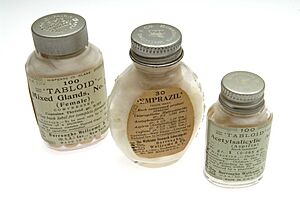Tabloid (newspaper format) facts for kids
A tabloid is a type of newspaper. It has a smaller page size compared to a broadsheet newspaper. There isn't one exact size for a tabloid, but they are always more compact.
Contents
What Does 'Tabloid' Mean?
The word tabloid first came from a medicine company called Burroughs Wellcome & Co. in London. In the late 1880s, they sold small, pressed pills called "Tabloid" pills.
Soon, people started using the word tabloid for other small, condensed things. In 1902, a newspaper said it would give "all the news in tabloid form." This meant the news would be short and easy to read. So, tabloid journalism first meant news stories that were simplified. Later, around 1918, the word also started to describe the smaller size of the newspaper itself.
Different Kinds of Tabloids
Tabloid newspapers, especially in the United Kingdom, can be very different. They aim for different readers, have different political views, and use different writing styles.
There are two main types of tabloid newspapers: red top and compact. The main difference is their writing style. Both types can have different political ideas, from socialism to conservative views. However, red-top tabloids often appeal to a wider audience because of their history.
Red-top tabloids are called that because their name at the top (the masthead) is often printed in red ink. The term compact was created to avoid the idea of "tabloid," which often makes people think of red-top tabloids.
Red-Top Tabloids: Exciting News!
Red-top tabloids are known for a style of writing called tabloid journalism. This style often focuses on exciting crime stories, astrology, and gossip columns about famous people and sports stars. They might also cover "junk food news," which means light, entertaining stories. Sometimes, the gossip about celebrities can be very personal.
These newspapers usually use simple words and grammar. Their layout often shows big pictures more than a lot of text. People sometimes say red-top tabloids are too dramatic or have strong political opinions. They have been accused of trying to create arguments or only reporting stories that grab attention. Sometimes, they are even accused of stretching the truth to sell more papers.
Examples of British red-top newspapers include The Sun, the Daily Star, and the Daily Mirror. Even though they don't use red mastheads, the Daily Mail and Daily Express also use a similar style of journalism.
Compact Tabloids: Serious News in a Smaller Size
In contrast to red-top tabloids, compact tabloids have a more serious writing style. This style is similar to what you would find in broadsheet newspapers. Many compact tabloids used to be broadsheet newspapers. They changed to a smaller size to make them easier to read in crowded places, like on a bus or train.
The word compact was first used in the 1970s by the Daily Mail. They were one of the first newspapers to switch to the smaller size. They wanted to avoid being linked to the dramatic style of red-top newspapers.
Some British newspapers that changed from broadsheet to compact size include the Daily Mail and the Daily Express in the 1970s. In 2003, The Independent also made the change, followed by The Scotsman and The Times. On the other hand, The Morning Star has always been tabloid-sized. It focuses on serious news and supports socialism, and is read by many blue-collar workers.
Compact tabloids, just like broadsheet newspapers, cover a wide range of political views, from progressive to conservative and from capitalist to socialist.
Tabloids Around the World
Tabloid newspapers are popular in many parts of the world.
- In South Africa, the Daily Sun is a very popular tabloid. It sells over 500,000 copies a day and is read by millions. It often covers unusual or supernatural stories, alongside regular news.
- In India, the first tabloid was Blitz, started in 1941. Today, Mumbai Mirror focuses on stories from Mumbai. Tehelka is known for its investigative journalism. Other popular tabloids include Mid-Day and MINT.
- In Europe, the Berliner format is a size between a tabloid and a broadsheet. Germany's Bild is the biggest tabloid in Europe by how many copies it sells. Many newspapers in Norway and Finland have also switched to the tabloid format.
- In North America, the New York Daily News started in 1919. Other well-known U.S. tabloids include the New York Post and Newsday. In Canada, many newspapers like The Province are also in tabloid format.
- In Australia, many newspapers like The Advertiser and the Herald Sun are tabloids.
- In Brazil, many newspapers are tabloids, including the sports daily Lance!.
Weekly Alternative Tabloids
The word 'tabloid' can also mean weekly or semi-weekly newspapers that are printed in the tabloid size. Many people who travel on subways or buses prefer these smaller papers because they are easier to read in tight spaces.
These newspapers are different from the big daily newspapers. They often offer an "alternative" point of view. This might mean they focus more on local news or are independent from large media companies.
These alternative weekly tabloids are usually published less often, and they are often free. They make money from advertisements. They tend to focus on local issues, even down to specific neighborhoods, and on local entertainment like bars and theaters.
Alternative tabloids can be aimed at different groups of readers:
- Upmarket (quality) newspapers appeal to people with more education and higher incomes. Their ads might be for organic food stores or theater companies.
- Middle-market (popular) newspapers are for a general audience.
- Downmarket (sensational) newspapers focus on exciting stories, similar to red-top tabloids. Their ads might be for trade schools or supermarkets.
All types of alternative tabloids usually have ads for local bars, car dealerships, movie theaters, and a section for classified ads.
See also



